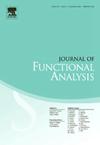具有多项式增长的Banach代数和有限自由变量的C∞函数的包络
IF 1.6
2区 数学
Q1 MATHEMATICS
引用次数: 0
摘要
对于一类Banach代数,我们引入了拓扑代数(特别是任意结合代数)包络的概念。对于多项式生长的实数Banach代数类,即承认对每个元素都有C∞泛函演算,我们得到了一个函子,它将k个变量的多项式代数映射到Rk上的C∞函数代数。一般交换或非交换代数的包络可以看作是在某些交换或非交换空间上的C∞函数的代数。特别地,我们描述了有限维李代数的普遍包络代数的包络,量子平面和量子群的坐标代数SL(2)的包络,并看了一些交换的例子。对于一般k,给出了自由C∞函数代数,即有限秩k的自由结合代数包络的一个结果,并证明了k≤2的包络。本文章由计算机程序翻译,如有差异,请以英文原文为准。
Envelopes in the class of Banach algebras of polynomial growth and C∞-functions of a finite number of free variables
We introduce the notion of envelope of a topological algebra (in particular, an arbitrary associative algebra) with respect to a class of Banach algebras. In the case of the class of real Banach algebras of polynomial growth, i.e., admitting a -functional calculus for every element, we get a functor that maps the algebra of polynomials in k variables to the algebra of -functions on . The envelope of a general commutative or non-commutative algebra can be treated as an algebra of -functions on some commutative or non-commutative space. In particular, we describe the envelopes of the universal enveloping algebra of finite-dimensional Lie algebras, the coordinate algebras of the quantum plane and quantum group and also look at some commutative examples. A result on algebras of ‘free -functions’, i.e., the envelopes of free associative algebras of finite rank k, is announced for general k and proved for .
求助全文
通过发布文献求助,成功后即可免费获取论文全文。
去求助
来源期刊
CiteScore
3.20
自引率
5.90%
发文量
271
审稿时长
7.5 months
期刊介绍:
The Journal of Functional Analysis presents original research papers in all scientific disciplines in which modern functional analysis plays a basic role. Articles by scientists in a variety of interdisciplinary areas are published.
Research Areas Include:
• Significant applications of functional analysis, including those to other areas of mathematics
• New developments in functional analysis
• Contributions to important problems in and challenges to functional analysis

 求助内容:
求助内容: 应助结果提醒方式:
应助结果提醒方式:


